Watershed Hydrological Responses to Land Cover Changes at Muger Watershed, Upper Blue Nile River Basin, Ethiopia
Abstract
1. Introduction
2. Materials and Methods
2.1. Study Area Description
2.2. Input Data
2.2.1. Topographic Factors
2.2.2. Land Cover
2.2.3. Soils
2.2.4. Meteorological Data
2.2.5. Hydrological Data
2.3. Hydrological Modeling
2.4. Sensitivity Analysis
2.5. Calibration and Validation
2.6. Performance Evaluation
2.7. Model Application
3. Results and Discussions
3.1. Performance Evaluation of the Hydrological Model
3.1.1. Sensitivity Analysis
3.1.2. SWAT Model Calibration and Validation
3.2. Land Cover Change Impacts on Hydrological Parameters in the Watershed
4. Conclusions
Author Contributions
Funding
Data Availability Statement
Acknowledgments
Conflicts of Interest
References
- Hyandye, C.B.; Worqul, A.; Martz, L.W.; Muzuka, A.N. The impact of future climate and land use/cover change on water resources in the Ndembera watershed and their mitigation and adaptation strategies. Environ. Syst. Res. 2018, 7, 1–24. [Google Scholar] [CrossRef]
- Gashaw, T.; Tulu, T.; Argaw, M.; Worqlul, A.W. Modeling the hydrological impacts of land use/land cover changes in the Andassa watershed, Blue Nile Basin, Ethiopia. Sci. Total Environ. 2018, 619, 1394–1408. [Google Scholar] [CrossRef]
- Marhaento, H.; Booij, M.J.; Rientjes, T.; Hoekstra, A.Y. Attribution of changes in the water balance of a tropical catchment to land use change using the SWAT model. Hydrol. Process. 2017, 31, 2029–2040. [Google Scholar] [CrossRef]
- Warburton, M.L.; Schulze, R.E.; Jewitt, G.P. Hydrological impacts of land use change in three diverse South African catchments. J. Hydrol. 2012, 414, 118–135. [Google Scholar] [CrossRef]
- Khare, D.; Patra, D.; Mondal, A.; Kundu, S. Impact of landuse/land cover change on run-off in the catchment of a hydro power project. Appl. Water Sci. 2017, 7, 787–800. [Google Scholar] [CrossRef]
- Maetens, W.; Vanmaercke, M.; Poesen, J.; Jankauskas, B.; Jankauskiene, G.; Ionita, I. Effects of land use on annual runoff and soil loss in Europe and the Mediterranean: A meta-analysis of plot data. Prog. Phys. Geogr. 2012, 36, 599–653. [Google Scholar] [CrossRef]
- Minta, M.; Kibret, K.; Thorne, P.; Nigussie, T.; Nigatu, L. Land use and land cover dynamics in Dendi-Jeldu hilly-mountainous areas in the central Ethiopian highlands. Geoderma 2018, 314, 27–36. [Google Scholar] [CrossRef]
- Leta, M.K.; Demissie, T.A.; Tränckner, J. Hydrological responses of watershed to historical and future land use land cover change dynamics of nashe watershed, ethiopia. Water 2021, 13, 2372. [Google Scholar] [CrossRef]
- Zhou, F.; Xu, Y.; Chen, Y.; Xu, C.-Y.; Gao, Y.; Du, J. Hydrological response to urbanization at different spatio-temporal scales simulated by coupling of CLUE-S and the SWAT model in the Yangtze River Delta region. J. Hydrol. 2013, 485, 113–125. [Google Scholar] [CrossRef]
- Tegegne, G.; Par, D.; Kim, Y. Comparison of hydrological models for the assessment of water resources in a data-scarce region, the Upper Blue Nile River Basin. J. Hydrol. Reg. Stud. 2017, 14, 49–66. [Google Scholar] [CrossRef]
- Waseem, M.; Kachholz, F.; Traenckner, J. Suitability of common models to estimate hydrology and diffuse water pollution in North-eastern German lowland catchments with intensive agricultural land use. Front. Agric. Sci. Eng. 2018, 5, 420–431. [Google Scholar] [CrossRef]
- Arnold, J.G.; Moriasi, D.N.; Gassman, P.W.; Abbaspour, K.C.; White, M.J.; Srinivasan, R.; Santhi, C.; Harmel, R.; Van Griensven, A.; Van Liew, M.W. SWAT: Model use, calibration, and validation. Trans. ASABE 2012, 55, 1491–1508. [Google Scholar] [CrossRef]
- Gassman, P.W.; Sadeghi, A.M.; Srinivasan, R. Applications of the SWAT model special section: Overview and insights. J. Environ. Qual. 2014, 43, 1–8. [Google Scholar] [CrossRef]
- Merga, D.D.; Adeba, D.; Regasa, M.S.; Leta, M.K. Evaluation of surface water resource availability under the impact of climate change in the Dhidhessa Sub-Basin, Ethiopia. Atmosphere 2022, 13, 1296. [Google Scholar] [CrossRef]
- Dile, Y.T.; Daggupati, P.; George, C.; Srinivasan, R.; Arnold, J. Introducing a new open source GIS user interface for the SWAT model. Environ. Model. Softw. 2016, 85, 129–138. [Google Scholar] [CrossRef]
- Fentaw, F.; Mekuria, B.; Arega, A. Impacts of climate change on the water resources of Guder Catchment, Upper Blue Nile, Ethiopia. Waters 2018, 1, 16. [Google Scholar] [CrossRef]
- Santos, R.M.B.; Sanches Fernandes, L.F.; Vitor Cortes, R.M.; Leal Pacheco, F.A. Hydrologic impacts of land use changes in the Sabor River Basin: A historical view and future perspectives. Water 2019, 11, 1464. [Google Scholar] [CrossRef]
- Mekonnen, D.F.; Duan, Z.; Rientjes, T.; Disse, M. Analysis of combined and isolated effects of land-use and land-cover changes and climate change on the upper Blue Nile River basin’s streamflow. Hydrol. Earth Syst. Sci. 2018, 22, 6187–6207. [Google Scholar] [CrossRef]
- Woldesenbet, T.A.; Elagib, N.A.; Ribbe, L.; Heinrich, J. Hydrological responses to land use/cover changes in the source region of the Upper Blue Nile Basin, Ethiopia. Sci. Total Environ. 2017, 575, 724–741. [Google Scholar] [CrossRef]
- Megersa, K.; Tamene, A.; Sifan, A. Impacts of land use land cover change on sediment yield and stream flow. Int. J. Sci. Technol. 2017, 6, 763–781. [Google Scholar]
- Galata, A.; Demissei, T.; Leta, M. Watershed hydrological responses to changes in land use and land cover at Hangar Watershed, Ethiopia. Iran. (Iran.) J. Energy Environ. 2020, 11, 1–7. [Google Scholar]
- Karamage, F.; Zhang, C.; Fang, X.; Liu, T.; Ndayisaba, F.; Nahayo, L.; Kayiranga, A.; Nsengiyumva, J.B. Modeling rainfall-runoff response to land use and land cover change in Rwanda (1990–2016). Water 2017, 9, 147. [Google Scholar] [CrossRef]
- Getachew, H.E.; Melesse, A.M. The impact of land use change on the hydrology of the Angereb Watershed, Ethiopia. Int. J. Water Sci. 2012, 1, 1–7. [Google Scholar] [CrossRef]
- Baker, T.J.; Miller, S.N. Using the Soil and Water Assessment Tool (SWAT) to assess land use impact on water resources in an East African watershed. J. Hydrol. 2013, 486, 100–111. [Google Scholar] [CrossRef]
- Hishe, S.; Bewket, W.; Nyssen, J.; Lyimo, J. Analysing past land use land cover change and CA-Markov-based future modelling in the Middle Suluh Valley, Northern Ethiopia. Geocarto Int. 2020, 35, 225–255. [Google Scholar] [CrossRef]
- Kidane, M.; Tolessa, T.; Bezie, A.; Kessete, N.; Endrias, M. Evaluating the impacts of climate and land use/land cover (LU/LC) dynamics on the Hydrological Responses of the Upper Blue Nile in the Central Highlands of Ethiopia. Spat. Inf. Res. 2019, 27, 151–167. [Google Scholar] [CrossRef]
- Gebrehiwot, S.G.; Bewket, W.; Gärdenäs, A.I.; Bishop, K. Forest cover change over four decades in the Blue Nile Basin, Ethiopia: Comparison of three watersheds. Reg. Environ. Chang. 2014, 14, 253–266. [Google Scholar] [CrossRef]
- Leta, M.K.; Demissie, T.A.; Tränckner, J. Modeling and prediction of land use land cover change dynamics based on land change modeler (Lcm) in nashe watershed, upper blue nile basin, Ethiopia. Sustainability 2021, 13, 3740. [Google Scholar] [CrossRef]
- Regasa, M.S.; Nones, M. Past and Future Land Use/Land Cover Changes in the Ethiopian Fincha Sub-Basin. Land 2022, 11, 1239. [Google Scholar] [CrossRef]
- Denekew, A.; Bekele, S. Characterization and Atlas of the Blue Nile Basin and Its Sub-Basins; International Water Management Institute: Addis Ababa, Ethiopia, 2009. [Google Scholar]
- Amare, A.; Simane, B. Climate change induced vulnerability of smallholder farmers: Agroecology-based analysis in the Muger sub-basin of the upper Blue-Nile basin of Ethiopia. Am. J. Clim. Change 2017, 6, 668–693. [Google Scholar] [CrossRef]
- Teshome, D.S.; Taddese, H.; Tolessa, T.; Kidane, M.; You, S. Drivers and Implications of Land Cover Dynamics in Muger Sub-Basin, Abay Basin, Ethiopia. Sustainability 2022, 14, 11241. [Google Scholar] [CrossRef]
- Teshome, D.S.; Moisa, M.B.; Gemeda, D.O.; You, S. Effect of Land Use-Land Cover Change on Soil Erosion and Sediment Yield in Muger Sub-Basin, Upper Blue Nile Basin, Ethiopia. Land 2022, 11, 2173. [Google Scholar] [CrossRef]
- Ali, M.G.; Ali, S.; Arshad, R.H.; Nazeer, A.; Waqas, M.M.; Waseem, M.; Aslam, R.A.; Cheema, M.J.M.; Leta, M.K.; Shauket, I. Estimation of potential soil erosion and sediment yield: A case study of the transboundary Chenab River Catchment. Water 2021, 13, 3647. [Google Scholar] [CrossRef]
- Neitsch, S.L.; Arnold, J.G.; Kiniry, J.R.; Williams, J.R. Soil and Water Assessment Tool Theoretical Documentation Version 2009; Texas United State Water Resources Institute: College Station, TX, USA, 2011. [Google Scholar]
- Abe, C.A.; Lobo, F.d.L.; Dibike, Y.B.; Costa, M.P.d.F.; Dos Santos, V.; Novo, E.M.L. Modelling the effects of historical and future land cover changes on the hydrology of an Amazonian basin. Water 2018, 10, 932. [Google Scholar] [CrossRef]
- Narsimlu, B.; Gosain, A.K.; Chahar, B.R.; Singh, S.K.; Srivastava, P.K. SWAT model calibration and uncertainty analysis for streamflow prediction in the Kunwari River Basin, India, using sequential uncertainty fitting. Environ. Process. 2015, 2, 79–95. [Google Scholar] [CrossRef]
- Chaibou Begou, J.; Jomaa, S.; Benabdallah, S.; Bazie, P.; Afouda, A.; Rode, M. Multi-site validation of the SWAT model on the Bani catchment: Model performance and predictive uncertainty. Water 2016, 8, 178. [Google Scholar] [CrossRef]
- Khalid, K.; Ali, M.F.; Abd Rahman, N.F.; Mispan, M.R.; Haron, S.H.; Othman, Z.; Bachok, M.F. Sensitivity analysis in watershed model using SUFI-2 algorithm. Procedia Eng. 2016, 162, 441–447. [Google Scholar] [CrossRef]
- Vilaysane, B.; Takara, K.; Luo, P.; Akkharath, I.; Duan, W. Hydrological stream flow modelling for calibration and uncertainty analysis using SWAT model in the Xedone river basin, Lao PDR. Procedia Environ. Sci. 2015, 28, 380–390. [Google Scholar] [CrossRef]
- Moriasi, D.N.; Arnold, J.G.; Van Liew, M.W.; Bingner, R.L.; Harmel, R.D.; Veith, T.L. Model evaluation guidelines for systematic quantification of accuracy in watershed simulations. Trans. ASABE 2007, 50, 885–900. [Google Scholar]
- Moriasi, D.N.; Gitau, M.W.; Pai, N.; Daggupati, P. Hydrologic and water quality models: Performance measures and evaluation criteria. Trans. ASABE 2015, 58, 1763–1785. [Google Scholar]
- Sao, D.; Kato, T.; Tu, L.H.; Thouk, P.; Fitriyah, A.; Oeurng, C. Evaluation of different objective functions used in the sufi-2 calibration process of swat-cup on water balance analysis: A case study of the Pursat river basin, Cambodia. Water 2020, 12, 2901. [Google Scholar] [CrossRef]
- Abbaspour, K. The fallacy in the use of the “best-fit” solution in hydrologic modeling. Sci. Total Environ. 2022, 802, 149713. [Google Scholar] [CrossRef]
- Gyamfi, C.; Ndambuki, J.M.; Salim, R.W. Hydrological responses to land use/cover changes in the Olifants Basin, South Africa. Water 2016, 8, 588. [Google Scholar] [CrossRef]
- Yan, B.; Fang, N.; Zhang, P.; Shi, Z. Impacts of land use change on watershed streamflow and sediment yield: An assessment using hydrologic modelling and partial least squares regression. J. Hydrol. 2013, 484, 26–37. [Google Scholar] [CrossRef]
- Tankpa, V.; Wang, L.; Awotwi, A.; Singh, L.; Thapa, S.; Atanga, R.A.; Guo, X. Modeling the effects of historical and future land use/land cover change dynamics on the hydrological response of Ashi watershed, northeastern China. Environ. Dev. Sustain. 2021, 23, 7883–7912. [Google Scholar] [CrossRef]
- Abbaspour, K.C. SWAT-CUP: SWAT Calibration and Uncertainty Programs—A User Manual; Eawag: Dübendorf, Switzerland, 2015; pp. 16–70. [Google Scholar]
- Leta, M.K.; Ebsa, D.G.; Regasa, M.S. Parameter Uncertainty Analysis for Streamflow Simulation Using SWAT Model in Nashe Watershed, Blue Nile River Basin, Ethiopia. Appl. Environ. Soil Sci. 2022, 2022, 1826942. [Google Scholar] [CrossRef]
- Niraula, R.; Meixner, T.; Norman, L.M. Determining the importance of model calibration for forecasting absolute/relative changes in streamflow from LULC and climate changes. J. Hydrol. 2015, 522, 439–451. [Google Scholar] [CrossRef]
- Nie, W.; Yuan, Y.; Kepner, W.; Nash, M.S.; Jackson, M.; Erickson, C. Assessing impacts of Landuse and Landcover changes on hydrology for the upper San Pedro watershed. J. Hydrol. 2011, 407, 105–114. [Google Scholar] [CrossRef]
- Abbaspour, K.C.; Vaghefi, S.A.; Srinivasan, R. A guideline for successful calibration and uncertainty analysis for soil and water assessment: A review of papers from the 2016 international SWAT conference. Water 2017, 10, 6. [Google Scholar] [CrossRef]
- Dias, L.C.P.; Macedo, M.N.; Costa, M.H.; Coe, M.T.; Neill, C. Effects of land cover change on evapotranspiration and streamflow of small catchments in the Upper Xingu River Basin, Central Brazil. J. Hydrol. Reg. Stud. 2015, 4, 108–122. [Google Scholar] [CrossRef]
- Panday, P.K.; Coe, M.T.; Macedo, M.N.; Lefebvre, P.; de Almeida Castanho, A.D. Deforestation offsets water balance changes due to climate variability in the Xingu River in eastern Amazonia. J. Hydrol. 2015, 523, 822–829. [Google Scholar] [CrossRef]
- Gebremicael, T.; Mohamed, Y.; Betrie, G.; Van der Zaag, P.; Teferi, E. Trend analysis of runoff and sediment fluxes in the Upper Blue Nile basin: A combined analysis of statistical tests, physically-based models and landuse maps. J. Hydrol. 2013, 482, 57–68. [Google Scholar] [CrossRef]
- Gwate, O.; Woyessa, Y.E.; Wiberg, D. Dynamics of land cover and impact on streamflow in the Modder River Basin of South Africa: Case study of a Quaternary catchment. Int. J. Environ. Prot. Policy 2015, 3, 31–38. [Google Scholar]
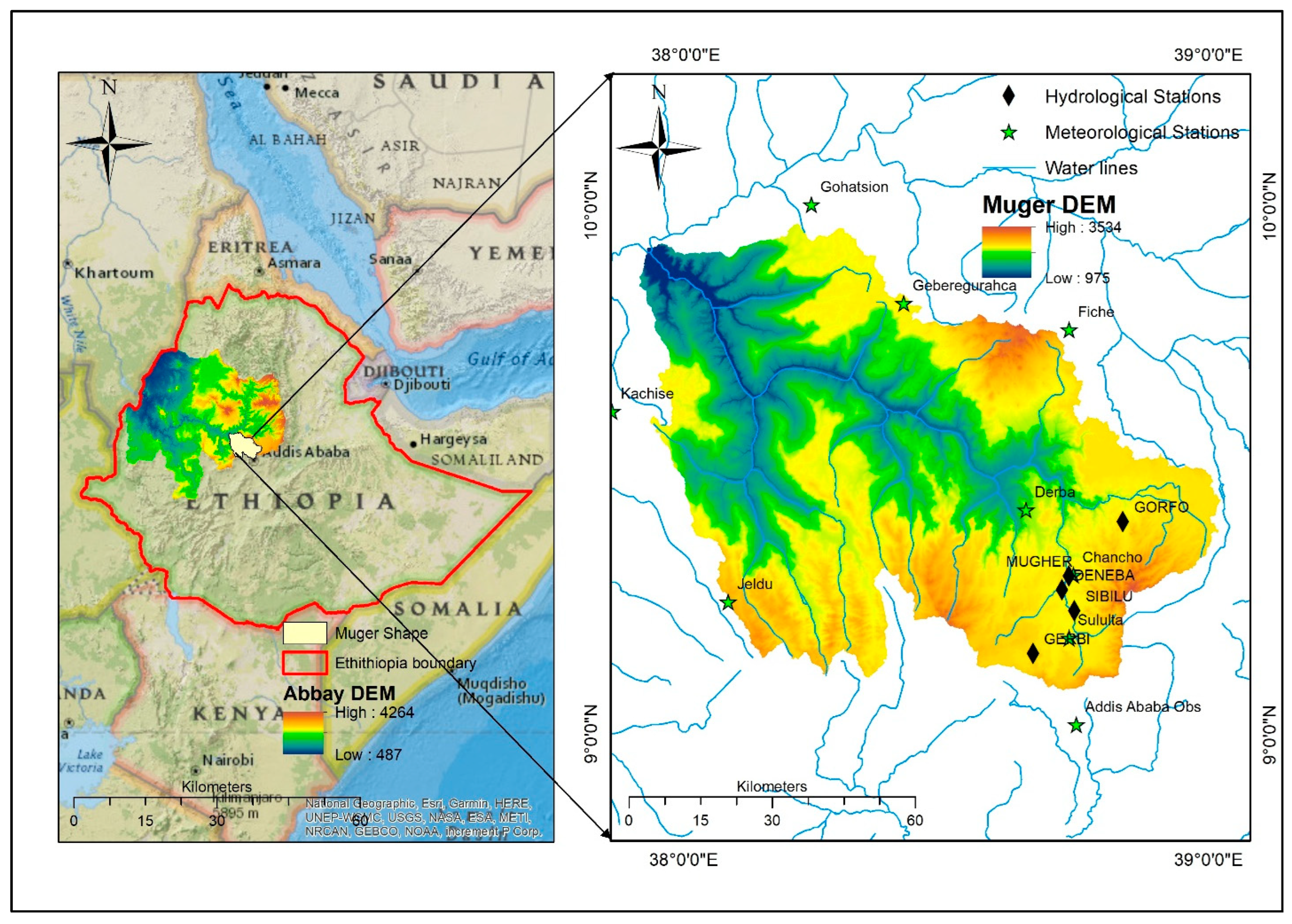

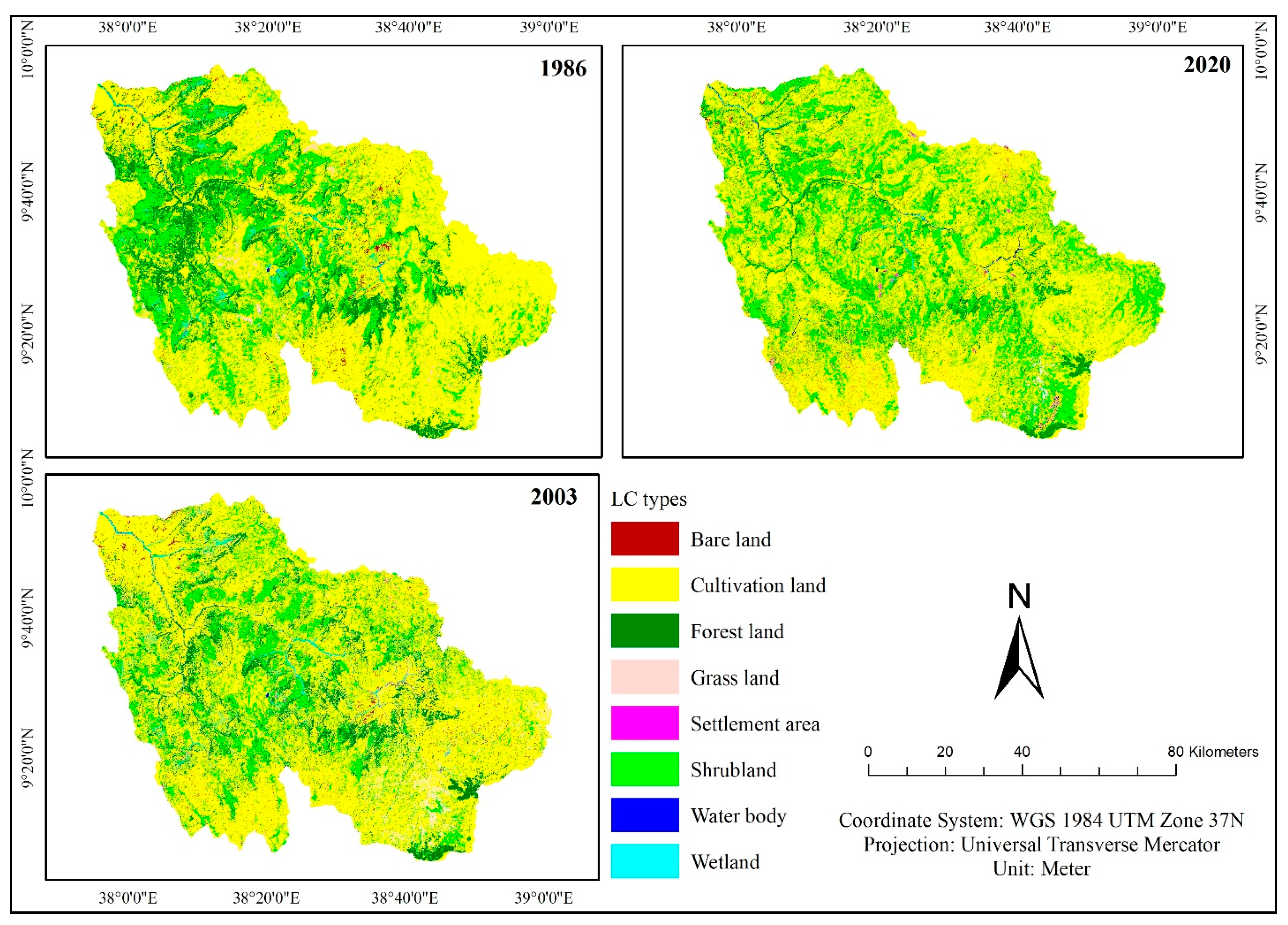

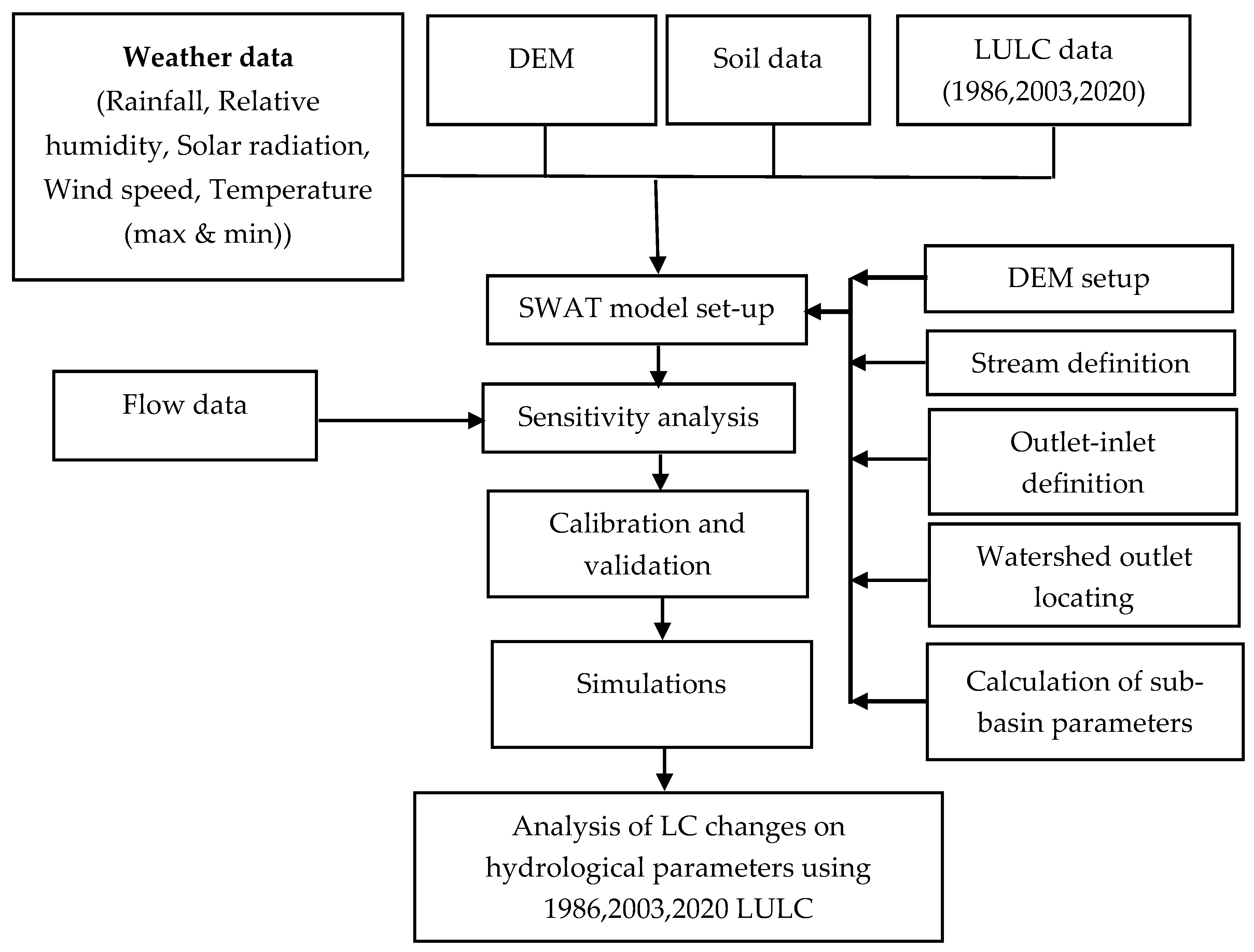

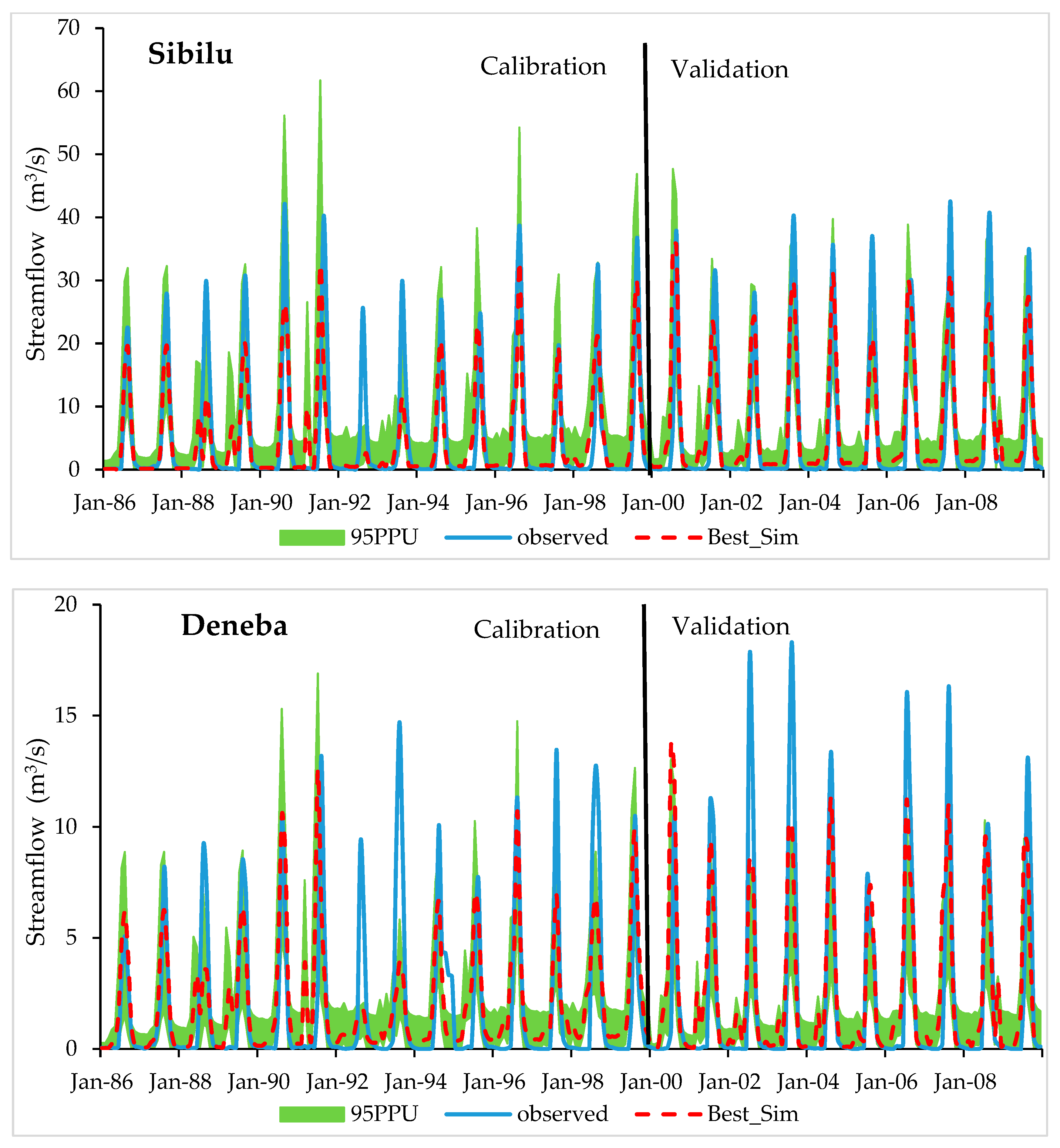

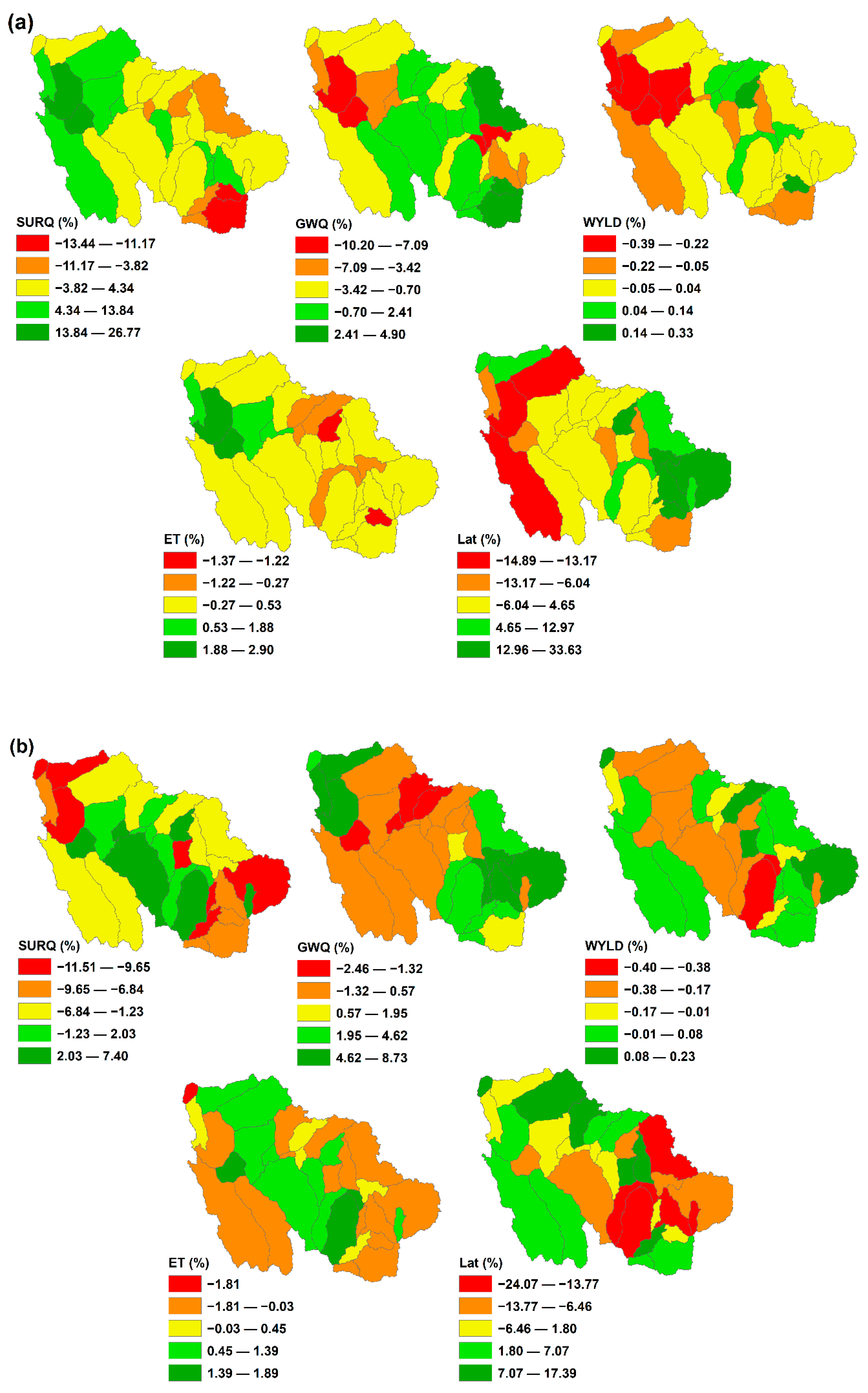

| Slope (%) | Area Coverage (km2) | % of Area Coverage |
|---|---|---|
| 0–5 | 1203.17 | 16.6 |
| 5–10 | 1401.59 | 19.34 |
| 10–15 | 1044.03 | 14.41 |
| 15–30 | 2353.29 | 32.48 |
| >30 | 1243.92 | 17.17 |
| LC Type | 1986 | 2003 | 2020 | Rate of Change (%) | ||||
|---|---|---|---|---|---|---|---|---|
| Area (km2) | Area (%) | Area (km2) | Area (%) | Area (km2) | Area (%) | 1986–2003 | 2003–2020 | |
| Bare soil | 84.23 | 1.16 | 63.93 | 0.88 | 38.23 | 0.53 | −31.74 | −67.25 |
| Cultivation | 5007.30 | 69.10 | 5210.29 | 71.91 | 5135.83 | 70.88 | 3.90 | −1.45 |
| Forest | 775.19 | 10.70 | 661.88 | 9.14 | 370.78 | 5.12 | −17.12 | −78.51 |
| Grass covered | 114.62 | 1.58 | 252.90 | 3.49 | 33.07 | 0.46 | 54.68 | −64.85 |
| Settlement | 2.25 | 0.03 | 50.79 | 0.70 | 112.78 | 1.56 | 95.57 | 54.97 |
| Shrubland | 1093.99 | 15.10 | 884.48 | 12.21 | 1496.86 | 20.66 | −23.69 | 40.91 |
| Waterbody | 168.42 | 2.32 | 121.72 | 1.68 | 58.47 | 0.81 | −39.51 | 14.20 |
| Total | 7246.00 | 100.00 | 7246.00 | 100.00 | 7246.00 | 100.00 | ||
| Soil Types | Area (km2) | Area Proportion (%) |
|---|---|---|
| Chromic Luvisols | 588.88 | 8.13 |
| Eutric Cambisols | 14.78 | 0.20 |
| Eutric Vertisols | 1231.93 | 17.00 |
| Haplic Luvisols | 304.69 | 4.20 |
| Haplic Nitisols | 184.74 | 2.55 |
| Humic Nitisols | 1071.71 | 14.79 |
| Lithic Leptosols | 158.96 | 2.19 |
| Rendzic Leptosols | 2920.14 | 40.30 |
| Vertic Cambisols | 770.17 | 10.63 |
| Total | 7246.00 | 100.00 |
| Station | Latitude (°N) | Longitude (°E) | PCP | T-Max | T-min | SSH | WND | HMD |
|---|---|---|---|---|---|---|---|---|
| Addis Ababa | 9.02 | 38.75 | ||||||
| Kachise | 9.61 | 37.86 | ||||||
| Fiche | 9.77 | 38.73 | ||||||
| Gohatsion | 10.00 | 38.24 | NA | NA | NA | |||
| Gebre guracha | 9.82 | 38.42 | NA | NA | NA | |||
| Derba | 9.43 | 38.65 | NA | NA | NA | |||
| Chancho | 9.30 | 38.74 | NA | NA | NA | |||
| Sululta | 9.18 | 38.73 | NA | NA | NA | |||
| Jeldu | 9.25 | 38.08 | NA | NA | NA |
| No. | Station Name | Latitude | Longitude | Area (km2) |
|---|---|---|---|---|
| 1 | Muger | 9.30 | 38.73 | 489 |
| 2 | Deneba | 9.27 | 38.72 | 86 |
| 3 | Sibilu | 9.23 | 38.74 | 380 |
| 4 | Gerbi | 9.15 | 38.67 | 88.6 |
| 5 | Gorfo | 9.40 | 38.84 | 49.2 |
| Performance Rate | NSE | PBIAS | R2 |
|---|---|---|---|
| Unsatisfactory | NSE ≤ 0.5 | PBIAS ≥ ±25 | R2 < 0.50 |
| Satisfactory | 0.5 < NSE ≤ 0.65 | ±15 ≤ PBIAS < ±25 | 0.50 < R2 < 0.70 |
| Good | 0.65 < NSE ≤ 0.75 | ±10 ≤ PBIAS < ±15 | 0.70 < R2 < 0.80 |
| Very good | 0.75 < NSE ≤ 1 | PBIAS < ±10 | >0.80 |
| Parameter Name | Muger | Sibilu | Gorfo | Gerbi | Deneba | |||||
|---|---|---|---|---|---|---|---|---|---|---|
| Rank | Fitted Value | Rank | Fitted Value | Rank | Fitted Value | Rank | Fitted Value | Rank | Fitted Value | |
| R__CN2.mgt | 1 | −0.1245 | 1 | −0.1396 | 1 | −0.1245 | 1 | −0.1775 | 1 | −0.1785 |
| R__SOL_K (..).sol | 2 | 1.2889 | 3 | 1.6599 | 10 | 1.2889 | 8 | 1.3243 | 4 | 1.8907 |
| V__ALPHA_BF.gw | 3 | 0.000069 | 5 | 0.00007 | 2 | 0.00007 | 2 | 0.00025 | 11 | 0.000241 |
| R__SLSUBBSN.hru | 4 | −0.1192 | 6 | −0.1192 | 14 | −0.1192 | 5 | −0.3848 | 9 | −0.2216 |
| R__CH_N2.rte | 5 | 6.2625 | 4 | 6.7500 | 13 | 6.2625 | 6 | 0.0755 | 5 | 2.1455 |
| V__CH_K2.rte | 6 | 4.165 | 2 | 16.6600 | 5 | 4.1650 | 9 | 0.3750 | 7 | 4.205 |
| R__HRU_SLP.hru | 7 | 5.47 | 7 | 5.4700 | 11 | 5.4700 | 7 | 4.9300 | 2 | 7.01 |
| R__SOL_AWC (..).sol | 8 | 1.974 | 8 | 1.9740 | 4 | 1.9740 | 13 | 2.2860 | 6 | 0.618 |
| V__GW_DELAY.gw | 9 | 3.765 | 10 | 87.6500 | 3 | 3.7650 | 4 | 0.5850 | 8 | 2.03500 |
| V__ESCO.hru | 10 | 0.9811 | 9 | 0.9055 | 12 | 0.9811 | 11 | 0.9227 | 10 | 0.9101 |
| R__OV_N.hru | 11 | −0.5464 | 12 | −0.5464 | 7 | −0.5464 | 12 | −0.3960 | 12 | −0.636 |
| V__GWQMN.gw | 12 | 2867 | 15 | 2867.00 | 9 | 2867.000 | 15 | 2913.00 | 13 | 2001.000 |
| R__SOL_Z (..).sol | 13 | 2.2605 | 13 | 2.2605 | 6 | 2.2605 | 3 | 2.4155 | 3 | 2.3485 |
| V__RCHRG_DP.gw | 14 | 0.000225 | 16 | 0.00023 | 15 | 0.00023 | 14 | 0.00037 | 15 | 0.000049 |
| V__REVAPMN.gw | 15 | 0.147 | 11 | 0.1470 | 8 | 0.1470 | 10 | 0.9050 | 14 | 0.98500 |
| V__GW_REVAP.gw | 16 | 0.1453 | 14 | 0.1453 | 16 | 0.1453 | 16 | 0.1447 | 16 | 0.1239 |
| Index | Calibration (1986–1999) | Validation (2000–2009) | ||||||||
|---|---|---|---|---|---|---|---|---|---|---|
| Muger | Sibilu | Gorfo | Gerbi | Deneba | Muger | Sibilu | Gorfo | Gerbi | Deneba | |
| R2 | 0.62 | 0.64 | 0.84 | 0.61 | 0.63 | 0.67 | 0.81 | 0.67 | 0.68 | 0.62 |
| NSE | 0.62 | 0.64 | 0.83 | 0.6 | 0.63 | 0.67 | 0.8 | 0.6 | 0.67 | 0.67 |
| PBIAS | −4.5 | 8.9 | −20.3 | −13 | −5.9 | 7.8 | −15.5 | −20.1 | −17.7 | 22.8 |
| p-factor | 0.74 | 0.79 | 0.77 | 0.74 | 0.74 | 0.76 | 0.72 | 0.74 | 0.78 | 0.73 |
| r-factor | 1.04 | 0.84 | 0.95 | 0.9 | 1.14 | 0.69 | 0.68 | 0.72 | 0.82 | 1.29 |
| Water Balance Components | 1986 | 2003 | 2020 | Rate of Change in % | ||
|---|---|---|---|---|---|---|
| 1986–2003 | 2003–2020 | 1986–2020 | ||||
| Surface runoff | 319.91 | 333.55 | 321.61 | 4.09 | −3.71 | 0.53 |
| Evapotranspiration | 229.3 | 229.8 | 230.6 | 0.22 | 0.35 | 0.56 |
| Lateral flow | 133.76 | 129.81 | 127.02 | −3.04 | −2.20 | −5.31 |
| Groundwater | 691.94 | 681.69 | 695.67 | −1.50 | 2.01 | 0.54 |
| Water yield | 1144.89 | 1145.05 | 1144.32 | 0.014 | −0.064 | −0.05 |
Disclaimer/Publisher’s Note: The statements, opinions and data contained in all publications are solely those of the individual author(s) and contributor(s) and not of MDPI and/or the editor(s). MDPI and/or the editor(s) disclaim responsibility for any injury to people or property resulting from any ideas, methods, instructions or products referred to in the content. |
© 2023 by the authors. Licensee MDPI, Basel, Switzerland. This article is an open access article distributed under the terms and conditions of the Creative Commons Attribution (CC BY) license (https://creativecommons.org/licenses/by/4.0/).
Share and Cite
Teshome, D.S.; Leta, M.K.; Taddese, H.; Moshe, A.; Tolessa, T.; Ayele, G.T.; You, S. Watershed Hydrological Responses to Land Cover Changes at Muger Watershed, Upper Blue Nile River Basin, Ethiopia. Water 2023, 15, 2533. https://doi.org/10.3390/w15142533
Teshome DS, Leta MK, Taddese H, Moshe A, Tolessa T, Ayele GT, You S. Watershed Hydrological Responses to Land Cover Changes at Muger Watershed, Upper Blue Nile River Basin, Ethiopia. Water. 2023; 15(14):2533. https://doi.org/10.3390/w15142533
Chicago/Turabian StyleTeshome, Dawit Samuel, Megersa Kebede Leta, Habitamu Taddese, Alene Moshe, Terefe Tolessa, Gebiaw T. Ayele, and Songcai You. 2023. "Watershed Hydrological Responses to Land Cover Changes at Muger Watershed, Upper Blue Nile River Basin, Ethiopia" Water 15, no. 14: 2533. https://doi.org/10.3390/w15142533
APA StyleTeshome, D. S., Leta, M. K., Taddese, H., Moshe, A., Tolessa, T., Ayele, G. T., & You, S. (2023). Watershed Hydrological Responses to Land Cover Changes at Muger Watershed, Upper Blue Nile River Basin, Ethiopia. Water, 15(14), 2533. https://doi.org/10.3390/w15142533









